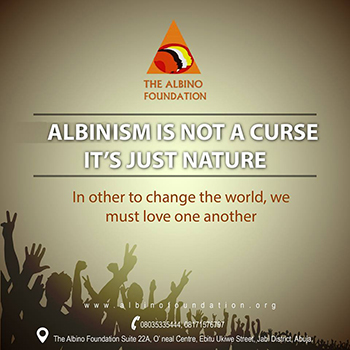Have you noticed how the student in your class stare at their book and the board sometimes with head bent to the side? Aha! You need to pay close attention to that child. These signs may not be conclusive but certainly, you need to stop, think, research and swing into action.
Albinism is a genetic condition where people are born with their bodies not able to produce melanin, the chemical responsible for hair, skin and eye colour- the reason why most people with albinism have pale skin and eyes with whitish hair. The colour of hair, skin, and eyes vary from one person to another. Not all persons affected by albinism have a uniform colour of hair, eyes, and skin hence the need to understand and the need to pay attention.
Types of albinism
Oculocutaneous albinism - have extremely pale skin and eyes, and white hair. Others with this same type of albinism might have slightly more colour in their hair, eyes, or skin.
Ocular albinism - affects only the eyes. People with ocular albinism usually have blue eyes. In some cases, the iris (the coloured part of the eye) has very little colour so a person's eyes might look pink or reddish. This is caused by the blood vessels inside the eye showing through the iris.
In some forms of ocular albinism, the hearing nerves hearing may be affected and the person may develop hearing problems or deafness over time.
Eyesight and Albinism
People with albinism often have trouble with their eyesight. They may wear glasses or contact lenses to help correct problems like short-sightedness, long-sightedness, or astigmatism. Others might need eye surgery. Just as there are different degrees of albinism there are also different levels of eye problems for a person who has the condition. Albinism does not make a person blind. Although some people with albinism have been found to be "legally blind" but that doesn't mean they have lost their vision completely. They can still read and study — they just may need larger print or magnifiers to help them. Some of the sight problems associated with albinism include:
- Crossed eyes: A disorder in which the eyes don’t look in exactly the same direction at the same. Characterized by poor eye muscle control.
- Sensitivity to light: An abnormal intolerance to visual perception of light.
- Involuntary rapid eye movement: The eyes make repetitive, uncontrolled movements. The movements can result in reduced vision, and depth perception and can affect balance and coordination. The movements can occur from side to side, up and down or in circular motions.
- Impaired vision or blindness: With visual impairment, normal activities become difficult for people. It is different from blindness which could be complete or incomplete.
- Astigmatism: Not outrightly an eye disease nor health problem, it’s a problem of how the eyes focus with light. Light fails to come to a single focus on the retina to produce clear vision, multiple focus points occur either in front or behind the retina. Squinting is a common symptom of astigmatism.
- Abnormal head positions: The head position is essential for proper seeing.
People living with albinism have difficulties coping with these conditions, particularly with the visual conditions. Long distance visual problems are usually worse than the short distance, and children in a classroom setting are not left behind.
Why Teachers should care
I discovered that the skin colour, which is the obvious indication for albinism varies from person to person. It’s easy to assume that someone affected by albinism is only just fair! While stigmatizing people living with albinism is common in our society, we should understand that Albinism does not affect intelligence but does affect the part of the body pivotal to the activities within the classroom.
Some signs that may help teachers are
- Discontinuing or doing certain activities differently
- Squinting or tilting the head to the side to focus on an object
- Having trouble identifying colours
- Write less clearly
- Hold reading materials very close to the eye
- Slower at reading and writing
To help students, teachers need to identify the students struggling with low vision and arrange the seats to help them. They should not be seated looking directly to sunlight or harsh lights. They should be given extra minutes to copy their notes if copying directly from the board, this also applies to reading from a projected screen. Check with the students to know how they fare with text fonts. Their test questions should be in larger fonts and given more time to write their exams.
Teachers can help enforce/ encourage an anti-bully environment. People with albinism standout with their struggles with vision hence the reluctance to keep their glasses on or use their magnifiers in class because of bullying or stigmatization.
The sensitivity to the sun may cause some students with albinism to avoid sports or the playground generally. Or they may be rejected by fellow students in team sports- anti-bully should then be encouraged in and out of the classroom.
Taking caring too far
Much like helping children with other challenges, the children need to be given enough time to learn how to deal with their challenges, so don’t overdo it. Don’t get too involved!
We live in a society where being different (physically) has a cultural, spiritual and even socio-economic undertone thereby entrenching discrimination as the victim is left to suffer the ignorance of those who deem themselves normal, complete or even privileged. Many students have been ‘left behind’ because they are different in some way. If we take some time to understand certain conditions and how they affect the students, coping with them or helping them live and learn with such conditions would be a lot easier.
To help teachers understand more about albinism, please visit The albino foundation website.













Comments